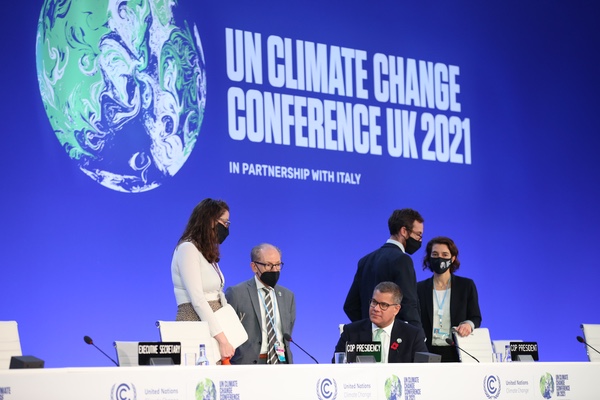An assessment of EU decarbonization options including astroelectricityby Mike Snead
|
| In short, a well-developed decarbonization plan must exist somewhere, right? What if such a plan doesn’t exist? |
Recently, the 26th UN Climate Change Conference (COP26) was held in Glasgow. In the leadup to and at the conference, there has been a flurry of “us too” pledges regarding decarbonization of countries and industries. For example, apparently six major car manufacturers pledged to end the production of carbon-fueled cars by 2040. Television advertisements by other large companies now promise similar decarbonization pledges.
Many politicians have become adherents to fervent environmentalism. Some urge that rapid and extreme measures be undertaken to decarbonize. Left in the wake of this fervor are middle-class people who lack the wealth to quickly “go green” while escalating fossil fuel prices driven by new decarbonization laws and regulations financially depletes their resources. While there are sound reasons to decarbonize in an orderly manner that does not penalize the middle class, taking an often-hysterical approach can only lead to chaos.
Providing assured supplies of energy affordable to the middle class is a moral responsibility of national governments as the failure to meet this need can have substantial financial, health, and political consequences. If a government pledges and, especially, if it imposes laws mandating decarbonization, then it is reasonable to expect that the practical means to achieve decarbonization has been quantitatively defined. In short, a well-developed decarbonization plan must exist somewhere, right? What if such a plan doesn’t exist?
The EU is a leading proponent of rapid decarbonization. In this article, a top-level quantitative analysis is undertaken to examine what practical options may exist for the EU to decarbonize. Three options are examined: nuclear fission power, terrestrial renewables, and space solar power-generated astroelectricity.
The EU’s 2019 energy use
Being the last year prior to the start of the global COVID-19 pandemic that suppressed economic activity, the year 2019 is used as the baseline for assessing EU decarbonization. Reflecting the fact that fossil carbon fuels still predominate energy use in the EU, the annual total energy use is reported using the energy unit of the tonne of oil equivalent (TOE). Essentially, all forms of industrial energy used are converted into the equivalent amount of oil that would have been otherwise used. This enables the total amount of energy used to be expressed using the TOE unit.
In 2019—not including Great Britain—the EU’s gross energy consumption totaled 1,454,020,000 TOE. Using the 2019 EU population, the per person energy consumption was 3.257 TOE. This energy was consumed directly in the form of electricity as well as heat and combustible fuels and through the goods and services used.
In 2019, the EU consumed 2,908,932 gigawatt-hours (GWh) of electrical energy. Thus, in 2019 the EU used 6,516 kilowatt-hours (kWh) per person.
To convert this amount of electrical energy into an equivalent TOE value, a conversion factor of 9,000 British thermal units (Btu) consumed per generated kWh is used. (1 TOE = 39,683,207 Btu) Thus, in 2019 the 6,516 kWh equates to 1.478 TOE. This means that of the total 3.257 TOE used, 45 percent was consumed in the form of electricity. The remaining amount of 1.779 TOE per person was used as combustible fuels for non-electricity generation purposes.
The orderly path to decarbonization
With decarbonization, electrical power will become the primary industrial power source. For this analysis, it is assumed that the same 45%/55% split in the end use of green energy will be maintained. As shown in Figure 1, the new decarbonized green energy infrastructure will then deliver green electricity, green hydrogen, and green carbon fuels.
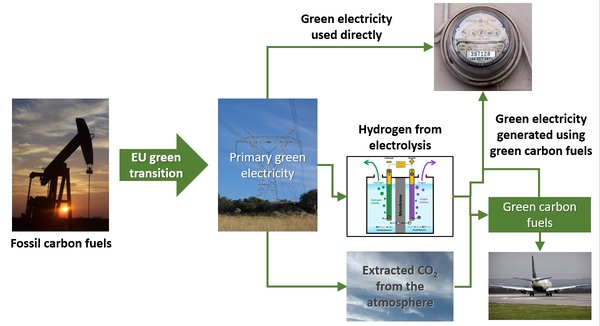 Figure 1 |
The essential environmental purpose of decarbonization is to eliminate the net addition of carbon dioxide into the atmosphere. As shown in Figure 1, green electricity is used to electrolyze water to yield green hydrogen. Additional green electricity is used to extract carbon dioxide from the atmosphere. These two are then chemically combined to yield synthetic carbon fuels that will replace, where needed, fossil carbon fuels. This process eliminates any net addition of carbon dioxide to the atmosphere. For this reason, these synthetic carbon fuels—likely methane and liquid fuels such as jet fuel—are properly called green carbon fuels. In this manner, where carbon fuels are still needed for practicality and safety, an orderly transition from fossil carbon fuels can be undertaken. Just as the industrialized world transitioned from wood to coal to oil and natural gas without diminishing the middle-class standard of living, this can be done again as the world transitions to green energy.
It is also noted that an engineered drawdown of the total carbon dioxide level in the atmosphere can be achieved using this same approach. Excess synthetic methane and oil can be produced to be injected into empty gas and oil fields deep underground. Not only will this be superior to concepts for the mass sequestration of carbon dioxide, but it provides an emergency energy supply should this be needed in the future.
With the growing environmental emphasis on expanding electrification, a reasonable question is why not just completely electrify the energy infrastructure? After all, electrification of ground transportation is expanding, and the use of other alternative electrical systems are increasing, such as heat pumps for winter heating.
| Decarbonizing the EU by 2050 will require building a total new green generating capacity capable of matching the output of 1,250 Hoover Dams running at full power for the entire year. |
The answer lies with the need to provide sufficient energy to meet demand at all times of the year despite weather conditions and other factors such as increased holiday use. Electricity cannot be readily directly stored. Thus, all electricity generated must either be consumed immediately or converted into another form of energy such as the chemical energy in batteries. To address hourly, daily, and seasonal changes in the demand for electrical power, storing excess green electrical energy in the form of green fuels enables gas turbine generators to readily be used to ensure that all demand is being met. This is not possible with variable sources such as wind and ground solar power.
Also, it is now apparent that some amount of dispatchable conventional generator use will need to be maintained. Essentially, as demand changes, the rotational inertia of the generators helps to maintain the stability of the power grids and the proper and safe functioning of electrical equipment. With gas turbine generators now being the primary means of handling demand variability, the expected continued use of these generators for this purpose will require producing green combustible fuels—either hydrogen or methane.
Amount of green electricity needed to produce green hydrogen and green methane
One TOE of hydrogen fuel has a mass of 344.6 kilograms. The advanced industrial scale electrolyzers now being developed are projected to require 51.3 kWh to yield 1 kg of hydrogen gas. Thus, 1 TOE of gaseous hydrogen would require 17,678 kWh. Liquification of 1 TOE of hydrogen would increase the total electricity needed to 21,123 kWh.
Using these estimates, if only hydrogen fuel is used, supplying the 1.779 TOE of fuels used in 2019 would require 37,578 kWh. When combined with the electrical energy used directly, the 2019 per person energy needs would be met with 44,094 kWh. This equates to a continuous primary green electrical power of 5 kW. For perspective, this is the power required by five countertop microwave ovens.
As discussed, an alternative to supplying hydrogen to the end users is to provide green carbon fuels. For comparison, instead of using green hydrogen, the entire needed green fuels will be met using synthetic methane—a molecule of one carbon atom and four hydrogen atoms. To supply the 1.779 TOE used as fuels in 2019, a total of about 54,280 kWh would be needed. This represents a 23 percent increase in the total electricity needed per person over the cryogenic hydrogen solution.
The advantage of the use of green carbon fuels is that much of the current natural gas and oil storage, transport, and distribution infrastructure would continue to be used. Converted refineries would manufacture these fuels using green hydrogen and carbon dioxide from the atmosphere. Also, the wide variety of carbon-derived industrial products—e.g., lubricants, tar, and feedstocks for pharmaceuticals, plastics, and clothing—would continue to be supplied where recycling alone cannot meet demand. If substantial green carbon fuels were to be used, the continuous primary green electrical power needed per person would be about 6 kW.
Total green electrical energy needed by the EU
Of the 2.9 million GWh generated in 2019, renewables and biofuels supplied 1 million GWh—about 35 percent. To fully decarbonize, the total green electricity generated needs to be increased nearly twenty-fold to 19.7 million GWh. This means that the total green electricity now generated is only about five percent of what is needed to fully decarbonize. When population growth is included for transition planning, the goal of decarbonizing the EU by 2050 with green electricity and hydrogen effectively means that the EU will need to almost completely replace its entire existing energy infrastructure with a new green energy infrastructure.
To help appreciate the magnitude of what this will involve, 19.7 million GWh equates to 2,247 GW-years of primary green electrical energy. The Hoover Dam has a nameplate generating capacity of about 2 GW. Decarbonizing the EU by 2050 will require building a total new green generating capacity capable of matching the output of 1,250 Hoover Dams running at full power for the entire year.
Assessing the nuclear fission energy option
In 2019, nuclear power supplied about 26 percent of the total electricity generated. Advocacy for building more nuclear fission power has increased in recent years. To meet all of the decarbonization need for 19.7 million GWh would require the expansion of the current installed nuclear generating capacity by a factor of 25.
With an assumed operating capacity factor of 95 percent for new plants, the equivalent of 2,365 1-GW plants would need to be built. To fuel these plants, nuclear fuel breeding would be needed as the world’s supply of natural uranium could not meet this need. Either plutonium or uranium-233 would need to be produced at a rate of over 1,000 kg for each 1-GW reactor per year. Both radioisotopes have been demonstrated to be able to be used in nuclear weapons.
Many EU countries are now emphasizing the phase-out of nuclear fission power, especially after the very serious nuclear accident in Japan in 2011 and the continuing concerns about the environmental impact of the Chernobyl plant accident almost 40 years ago. With serious concerns about safely locating nuclear plants, about safe and effective nuclear waste disposal, and about the threat of nuclear weapon proliferation, it is unlikely that a substantial expansion of nuclear fission power will be undertaken in the EU.
Assessing the terrestrial renewables (wind and ground solar power) options
The U.S. National Renewable Energy Laboratory (NREL) has studied the commercial use of wind and ground solar power for a considerable period. They have produced estimates of the amount of annual electrical energy that wind and ground solar farms can produce in an average year.
| To supply 19.7 million GWh, 2.6 million square kilometers of commercial wind farms would be needed. The required land area is nearly 60 percent of the total EU land area. |
For wind power, NREL estimates that commercial land wind farms in the United States have an optimum installed nameplate generating capacity of around 0.0025 GW per square kilometer. They also assume that the annual net capacity factor for well-located commercial wind farms is 35 percent. Thus, each square kilometer of wind farms would be expected to generate 7.665 GWh in an average year. It is assumed that commercial wind farms in the EU would have similar generation values.
To supply 19.7 million GWh, 2.6 million square kilometers of commercial wind farms would be needed. The required land area is nearly 60 percent of the total EU land area. The electrical energy output of each square kilometer of wind farms would meet the annual energy needs of about 170 people. This low value highlights the fact that wind power is actually a poor power source in terms of the land and physical resources needed to generate electrical power.
For ground solar power, NREL estimates that commercial ground solar farms have an average installed nameplate generating capacity of around 0.033 GW per square kilometer. In the US, the assumed annual net capacity factor is 25 percent—a value that would likely be optimistic for much of the EU. (For example, the installed solar capacity factor in Germany in 2019 was around 11 percent.) With the 25 percent capacity factor, each square kilometer of ground solar farm would generate 72.27 GWh in an average year.
To supply 19.7 million GWh, about 273,000 square kilometers of ground solar farms would be needed assuming a 25 percent capacity factor. The required land area then becomes about six percent of the total EU land area. With this optimistic capacity factor assumption, each square kilometer of ground solar farms would meet the annual energy needs of about 1,650 people. For perspective, each person would need about 600 square meters of solar farm. However, in Germany, this would increase to around 1,400 square meters per person due to the lower capacity factor.
The variability of wind and ground solar remains an important planning consideration. Figure 2 shows the impact of variability on wind power in Germany for the period of 1990–2003. Substantial seasonal and yearly variability was experienced. While newer wind turbines will probably reduce the degree of variability, significant variability is still seen in the output of newer wind farms in the United States. In some manner, this variability must be accommodated to ensure a stable power supply able to meet demand at all times.
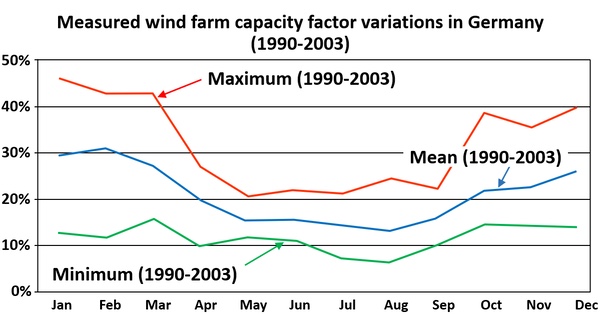 Figure 2 |
While the storage of excess energy in batteries, pumped storage, and chemical fuels will help to address this variability, the expansion of the total land area of wind and ground solar farms will likely be needed to minimize disruptions and meet seasonal and yearly variability. However, without a baseload (dispatchable) generation capacity, the threat of natural variations creating energy shortages remains. In times of severe weather as happened in Texas this past February, energy shortages can have severe consequences. During that crisis, the substantial installed wind and solar capacity, due to snow coverage, low wind speeds, and icing, was of little use in meeting the state’s electricity needs.
Assessing the astroelectricity option
Figure 3 illustrates one space solar power concept developed by NASA. By capturing about 26 GW of solar power, the system would be able to deliver 5 GW of dispatchable electrical power from the ground receiving station called an astroelectric plant. When located in geostationary Earth orbit (GEO), the capacity factor of this plant should be greater than 99 percent. Only when the GEO platform enters the Earth’s shadow around local midnight during the couple of weeks near the spring and fall equinoxes would astroelectricity not be delivered. During that time of the year, energy use is usually at a seasonal low. Gas turbine generators fueled with green hydrogen or green methane, normally used to meet peak electricity needs, would be used during these brief periods when astroelectricity is not available.
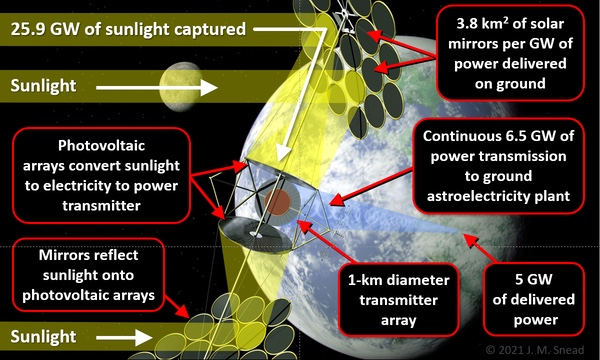 Figure 3 |
For this NASA baseline, the key planning parameter is the size of the astroelectric plant. For plants located at the mid-latitude of 35 degrees, the size is shown in Figure 4. In total, 164 square kilometers of land would be needed. Like solar farms, this land would need to be fairly level.
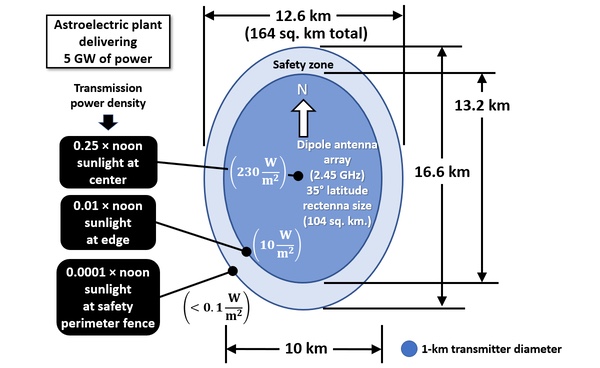 Figure 4 |
Integrating astroelectricity into an EU green energy solution
For this analysis, a 20%/80% split in the terrestrial/astroelectricity green electricity supply is assumed to meet the total need of 19.7 million GWh. Nuclear and terrestrial renewables would then need to supply, on average, about 4 million GWh. This would require an expansion of these two sources by a factor of about two. Astroelectricity would provide the balance of about 16 million GWh.
| The incorporation of astroelectricity as a substantial part of the green energy solution makes this goal achievable later this century with quite modest land use needs. The key question for the EU becomes—does common sense outweigh fervent environmentalism? |
For the portion coming from astroelectricity, this would require about 360 5-GW astroelectric plants. The total land area needed would be about 60,000 square kilometers. This would require the use of just over one percent of the EU land area.
If solar photovoltaic arrays and the astroelectric receiving antenna elements can be integrated into a single ground unit, the output of ground solar electricity from just the astroelectric plants alone would supply around 20 percent of the 19.7 million GWh needed. Further substantial ground solar and wind farms may not then be needed. This could be a good WIN-WIN technical solution for the EU.
Conclusion
While the EU objective to become climate neutral is a wise goal, achieving this by 2050 does not appear to be possible without an overwhelming build-out of wind and ground solar farms. However, the incorporation of astroelectricity as a substantial part of the green energy solution makes this goal achievable later this century with quite modest land use needs. The key question for the EU becomes—does common sense outweigh fervent environmentalism?
Note: we are using a new commenting system, which may require you to create a new account.
